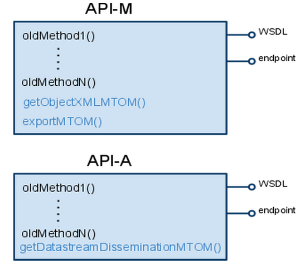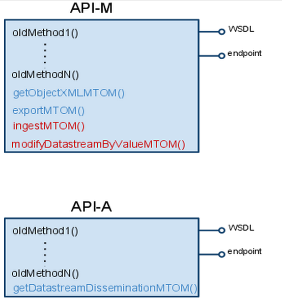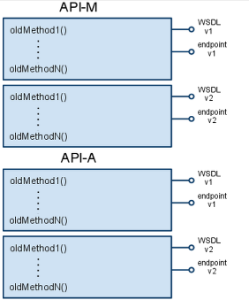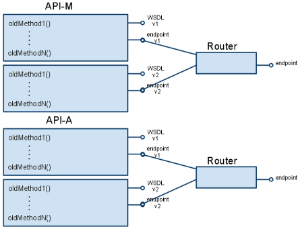| Table of Contents |
|---|
MTOM Support on the WSDL Level
...
In other words, only new xml attribute expectedContentTypes from namespace with URI http://www.w3.org/2005/05/xmlmime is set to the value application/octet-stream.
Affected API-M Methods
- ingest
- getObjectXML
- export (response)
- modifyDatastreamByValue
Wiki Markup
Affected API-A Methods
- getDatastreamDissemination
...
Methods marked as <span style="color: #ff0000">red</span> has an input parameter of type *byte\[\]* and <span style="color: #0000ff">blue</span> methods has output value of type *byte\[\]*as red has an input parameter of type byte[] and blue methods has output value of type byte[].
Changes to WSDL
Since API-A and API-M wsdl files both use the include directive inside their <types> element, the changes will be made only to fedora-types.xsd.
...
- One WSDL rule them all
- MTOMize only "blue" operations
- MTOMize all MTOMizable operations
- New WSDLs and endpoints for MTOMized version of API
- Routing (Mediator Pattern)
Visualization in pseudo UML
1.a
& 1.b
...
2. (the lower rectangles are MTOM enabled)
...
3.
1.b
Pros:
- 1.a
- The easiest solution
- The smallest set of operations in the API.
- No need for new endpoints/wsdls
- 1.b
- Consistent (all MTOM operation has "MTOM" in name)
- Still easy
- No need for new endpoints/wsdls
- 2.
- 100% guarantee of backward compatibility
- This method is the best practise, when doing backward compatible changes to WS API
- 3.
- The WS endpoints remain the same and can handle all versions of API based on the particular namespace (now the namespace inside the SOAP messages is http://www.fedora.info/definitions/1/0/types/. I suggest something like http://www.fedora.info/2011/7/[definitions/types/|http://www.fedora.info/definitions/2011/7/29/types/] (W3C convetion)).
- will not break "low lvl clients" i.e. clients that are not generated from wsdl like curl, because the endpoint is still the same and if such "low lvl client" wants to start use new version of WS the only change for him is to change the structure of SOAP by changing the namespace. In the Java/.NET world this is a minor advantage, but if the client is written in, say, bash, it may help.
- probably most robust solution with keeping in mind the possible future changes to API (once the infrastructure around is implemented, the addition of new version of API is easier)
Cons:
- 1.a
- It is not transparent for the client when calling, say, ingest() whether the request is MTOMized or not, since the server-side can handle both. This will hold also for method ingestMTOM() from solution 1b).
- Not consistent in that sense that not all methods which use MTOM have "MTOM" suffix in their name.
- 1.b
- More operations
- 2.
- 4x wsdl (2x API-A + 2x API-M) + 4x endpoint
- More complicated
- There is need to maintain more methods which will be probably the object of deprecation sometimes in the future
- 3.
- 4x wsdl (2x API-A + 2x API-M) + 6x endpoint
- More complicated, the know how of CXF is needed to implement the router as an interceptor
The Winner
To be honest, I don't know. I would suggest the solution number 3. i.e. the router and new WSDLs, because it seems to me the best choice for possible future changes to Fedora's API. I had also some discussion with my friends which support this proposal.
Namespaces
suggestion:
prefix | old | new |
|---|---|---|
fedora-types | http://www.fedora.info/definitions/1/0/types/ | http://fedora-commons.org/2011/07/definitions/types/ |
fedora-api | http://www.fedora.info/definitions/1/0/api/ | http://fedora-commons.org/]2011/07/definitions/api/ |




